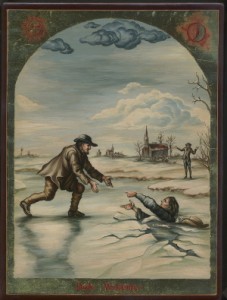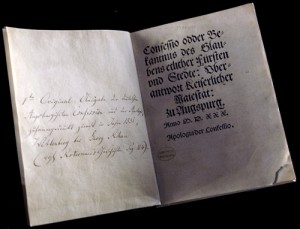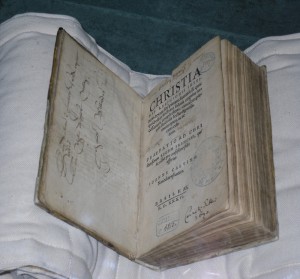Beginning of the Protestant Reformation
(1) Erasmus publishes the Handbook of the Christian Soldier (1503) – Desideratus Erasmus published a book called The Handbook of the Christian Soldier and quickly became known as the prince of the humanists. A ‘humanist’ at this time was a scholar who sought to restore the literary glories of antiquity and the study of all “humanities” subjects. (This idea was eventually abased to the large number of 20th century humanities majors who sought to abuse them.) Erasmus and his fellow humanists sought reformation of customs, the practice of decency and moderation, and a combination of learning and meditation that shaped and changed human behaviors. In short, they valued doctrine, but they valued obedience even more. Erasmus’ writings encouraged many of the reformers, and though he would part ways doctrinally with them, his works could be considered some of the tinder upon which the sparks of Luther’s passion caught flame.

(2) Luther Nailing the 95 Thesis on the door at Wittenberg (1517) – October 31, 1517, Martin Luther, a professor at the University of Wittenberg, posted a paper in Latin on the cathedral door designed to spark debate among the clergy at the University. His last attempt at teaching some radical ideas had received little more than yawns, he perhaps held out little hope for this paper. He probably expected it to get no farther than the local theological journal. But someone translated it into German and it caused an uproar because it spoke against the very method that the lord and prelates and the church itself used to reap monetary profit – the sale of indulgences. These 95 theses set off the spark that became the protestant reformation.

(3) Luther before the Imperial Diet at Worms (1521) – In 1521, Luther was called before the Diet of Worms (what a name, right!?) to answer for his treasonous statements. He was called to recant his writings or to be excommunicated from the church. Luther had never sought separation from the church, but had encouraged reformation of the church from within. But the Holy Roman Emperor and the Pope had decided that this rebellion needed to be squelched. Luther asked for a night to consider (smart move), but on the next day he uttered words that encourage all who hold to the authority of scripture. “My conscience is held captive by the word of God. I cannot and will not recant for to obey one’s conscience is neither just nor safe. God help me. Amen.” Luther did not blink and the reformation was unstoppable.

(4) Luther at Wartburg translates the new Testament into German (1521 – 1523) – Originally Luther had been ‘kidnapped’ after his capture had been called for by the emperor. It turns out the kidnappers were friends or supporters of Luther who took him to Wartburg. While in ‘hiding’ there he translated the New Testament into the ‘vulgar’ or common German language. Aside from just providing a translation of the New Testament for Germans to read and study for themselves, this translation (and his later Old Testament translation) served to standardize the German language itself and lead to a phase of literary German that had not occurred prior.

(5) Founding of the Anabaptists and the Baptism of Blaurock & Grebel (1525) – Every movement of change has its radical members. One such group was founded by the mutual re-baptism of the founders of the Anabaptists, Blaurock and Grebel. The Anabaptists (or re-baptizers) were a group of Christians who felt that only believers should be baptized and that all infant baptism, or baptisms performed only as a ritual to become a member of a church were not valid. They believed only in the baptism of professing believers. They also believed there should be a contrast or a separation between the structure of the church and the structure of government. Both of these beliefs were seen as a threat to the established order since the church and its rituals were part of the social and political fabric of the times. For this reason they were persecuted by both protestants and Catholics.

(6) Confession of Schleitheim (1527) (bonus if you can pronounce it) – In response to the Catholic states of Switzerland and the Council of the Government of Zurich (protestant) condemning them to death, the Anabaptists wrote down the seven fundamental beliefs which they believed. Carrying on the confessional nature of Christianity, they judged it only fair that if they would be condemned in both civil and ecclesiastical courts, then the world ought to know why they were being condemned.

(7) Turks defeated at Vienna (1529) – In the midst of the turmoil created by the reformation, the fragile alliance of various powers of Christendom was critical. The reformation was allowed to grow in part because of the threat of an external power, the Muslim Turks. The Holy Roman Emperor could not afford to alienate his alliance of princes by any strong force of power against the protestants when the Turks were seeking to take territory from him. The breaking of the siege at Vienna required an alliance of many major powers, both protestant and Catholic. The Turks were defeated at Vienna, but their continued threat forced the Emperor to allow the princes to continue to practice their Protestantism in order for him to have their continued support.

(8) Augsburg Confession (1530) – Charles V returned to Germany to attend the Diet of Augsburg. He has not listened to Luther in 1521, but this time he ordered an exposition of the points at issue. The result of this request, written by Philipp Melanchthon, is now known as the Augsburg Confession. This confession presented a summary of the protestant beliefs and was signed by most of the Princes and Lords of Germany to present a united front to the Emperor. Despite the Emperor’s call to recant, the Princes held firm in their resolution. For some time after this the Lutherans referred to themselves as “Christians of the Augsburg Confession.” The Emperor eventually signed the Peace of Nuremburg in 1532 with the Princes allowing them to practice their faith.

(9) The Act of Supremacy (1534) – England’s King Henry VIII had originally been a great supporter of the Catholic church against the ‘scourge’ of Luther’s heresy, but eventually he came into conflict with the Pope. While Henry did not agree with Protestantism, he did not appreciate what he believed was the Papacy’s interference with the authority of the Crown. In 1534, at his behest, Parliament declared Henry the “supreme head of the church of England” and annulled his marriage to Catherine.

(10) Calvin goes into Exile in Switzerland (1535) – In 1533 at the College Royal in Paris, a close friend of Calvin, Nicholas Cop, devoted his inaugural address to address the need for reform and renewal in the catholic church. Cop who was branded a heretic and Calvin was implicated in his offense and forced into hiding for a year. After Francis I of France decided he would no longer tolerate Protestantism, Calvin fled to Switzerland where he joined Cop in Basel. Later the majority of Calvin’s ministry would be spent in Geneva.

(11) First Edition of Institutes of the Christian Religion published (1536) – Only one year after arriving in Switzerland, the first edition of the Institutes of the Christian Religion was published. It would undergo several more published editions before Calvin died (no one is quite sure whether Calvin was actually finished, but God must have felt he was). This work went form 6 chapters in the first edition to 4 books in the final edition of 1559. It was the first work of systematic theology from the Protestant reformation and as such would influence all systematic doctrines to follow. It was developed to formulate the proper doctrine from the Bible and from previous theologians, back to Augustine in a form that could be widely read and understood in order to combat the heresies and errors of the age.

Notice the importance of the written word to the historical faith. In both confessions of belief, systematic theology and, above all, in translations of the Bible, the Christian faith is a faith of words.